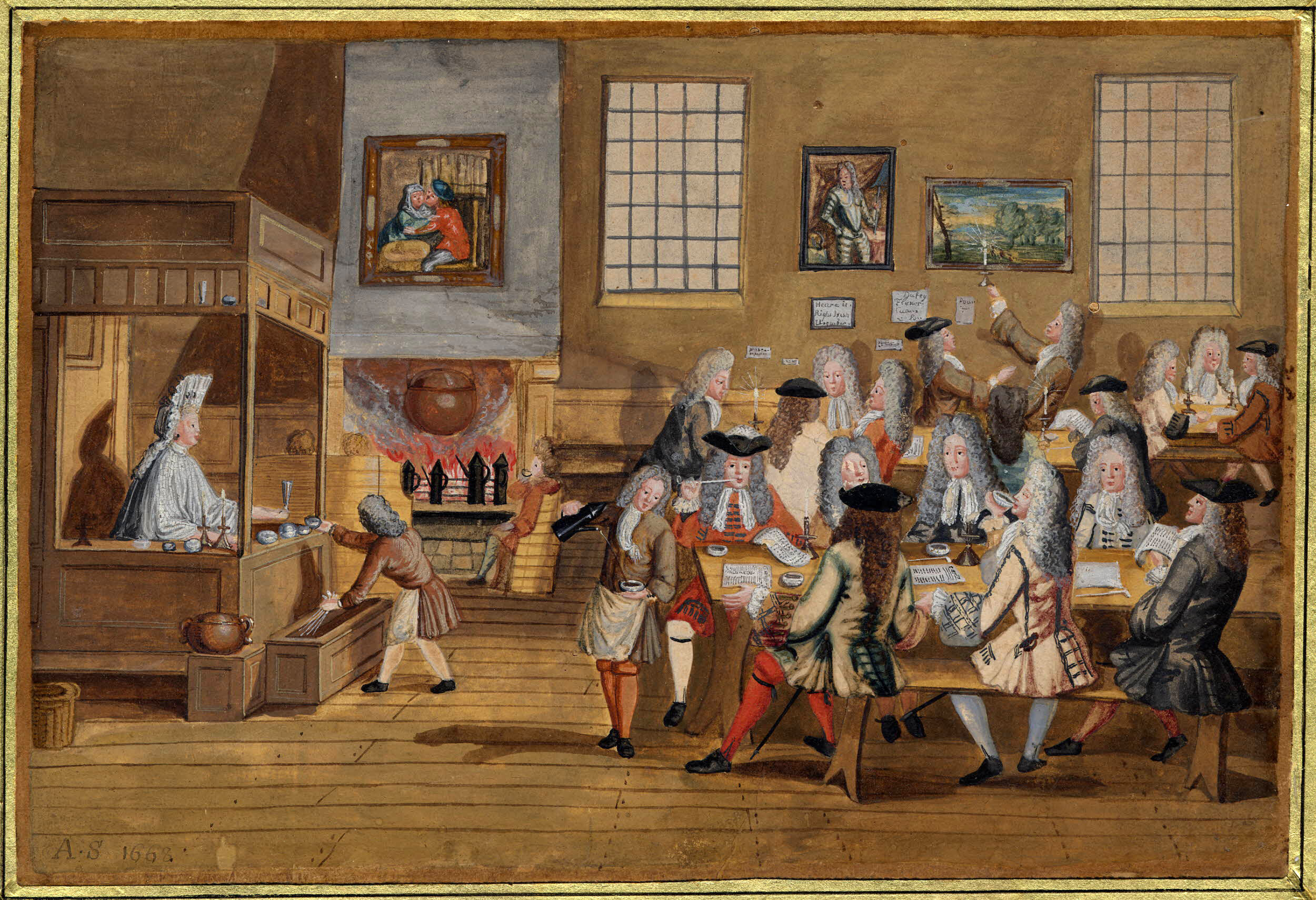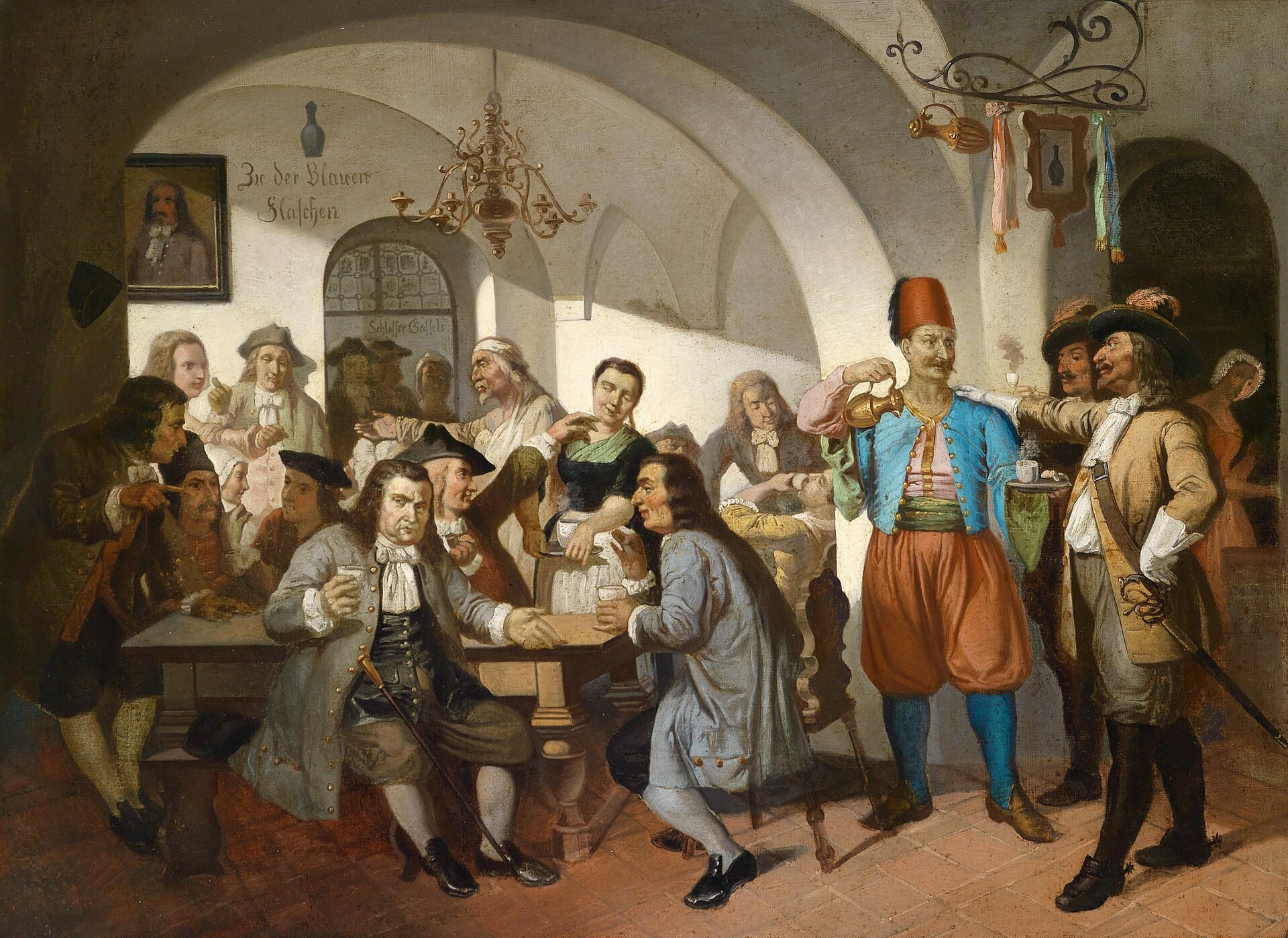Coffee houses transformed British society in the 17th and 18th centuries. But who visited coffee houses, and why?
The French writer Maximilien Misson enjoyed visited London’s coffee houses in the late 17th century. “You have all manner of news there,” Misson reported. “You have a good fire, which you may sit by as long as you please. You have a dish of coffee; you meet your friends for the transaction of business, and all for a penny.”
Coffee houses exploded in 17th century England and transformed society in the 18th century. Why did England go crazy for coffee, and how did coffee houses change history?
A London coffee house, c. 1700. © Trustees of the British Museum
The Rise of the Coffee House
In 1652, Pasqua Rosée opened the first coffee house in London. Rosée, who came to England as a servant, brought a lifetime of experience drinking coffee in Turkey.
Londoners flocked to the coffee house. They ordered drinks “black as soot, and tasting not much unlike it,” according to trader William Bidulph. By 1675, England boasted over 3,000 coffee houses.
The link between students and coffee began early. Cambridge and Oxford hosted multiple competing coffee houses. Visitors tossed back cups of coffee while debating academic matters. Outsiders even called the coffee houses “penny universities.” For the price of a penny, patrons indulged in their academic interests.
For years, coffee houses were associated with educated men and well-off traders. But soon, London’s coffee houses found an even broader clientele.
Coffee as Medicine
Was coffee harmful––or did it cure? In the 17th century, the English debated the properties of the strange beverage.
Francis Bacon performed experiments on coffee even before coffee houses sold the beverage. According to coffee supporters, the beverage cured “head-melancholy” and drunkenness. Coffee supposedly treated gout, survey, and even smallpox.
Yet in excess, coffee could also harm. The drink caused tremors in high doses and potentially contributed to heart conditions. One experimentalist worried the beverage could cause paralysis.
A still life by Christian Berentz, c. 1700. Galleria Nazionale d'Arte Antica
The ills caused by coffee went beyond physical ailments, according to an anonymous pamphlet published in 1674. The Women’s Petition Against Coffee attached the “newfangled, abominable, heathenish liquor called coffee.”
Coffee Houses as Meeting Places
As coffee houses opened across England, they catered to different interests.
Some coffee houses had a reputation for scholarly discussions. Others offered Latin lessons or poetry recitals. Natural philosophers hashed out disagreements on astronomical principles over a cup of coffee.
But not every coffee house focused on learning. Moll King’s coffee house in Covent Garden earned a reputation for welcoming the neighborhood’s prostitutes.
A painting showing an early modern coffee house.
The diarist Samuel Pepys enjoyed visiting London’s coffee houses in the 1660s. Pepys praised the coffee houses as an excellent place to transact business––and hear gossip.
Businessmen turned coffee houses into workplaces. Many established predictable hours at their favorite coffee houses, where clients would pop in to discuss the latest business. Businessmen even received mail at coffee houses.
Tom’s Coffee House, located in the City of London, welcomed bankers. Stockbrokers flocked to Garraways Coffee House and Jonathan’s Coffee House. The Latin Coffee-House by St. Paul’s welcomed book publishers.
A list of rules and orders for visitors at an English coffee house.
Lloyd’s Coffee House became the merchant and sailor destination. Edward Lloyd, the founder, shared news on shipping. Clients bought and sold so many maritime insurance policies that the coffee house eventually evolved into Lloyd’s of London, still a major insurer today.
Other coffee houses welcomed nonconformists. Religious and political dissidents found homes at coffee houses – after the Restoration, King Charles II tried to shut down coffee houses.
According to the monarch, coffee houses “have produced very evil and dangerous effects.” Men plotted against the king over coffee, Charles suspected, leading him to declare coffee houses a “disturbance of the peace and quiet of the realm.”
The proclamation stirred an instant backlash. The king backed down two weeks later.
Print Culture and the Coffee House
Coffee houses shared news and distributed pamphlets. London’s first daily newspaper began printing in 1702. Between editions of the London Courant, runners visited coffee houses to share breaking news.
The “Wet Paper Club” at the Chapter Coffee House bragged that their news was so fresh, the pages were still wet with ink.
A pamphlet arguing against coffee and coffee houses from 1674.
Politics and trade dominated coffee house news. But patrons also wanted gossip, satire, and moralizing tales. Many coffee houses offered newspapers and pamphlets for free with the cost of admission. Some read the news out loud to encourage debate.
Coffee houses were more than a place to meet or conduct business. They became libraries with everything from the latest news from the colonies to scandalous broadsheets.
Women and Coffee Houses
Although coffee houses claimed to admit anyone, in practice women were largely excluded.
Rather than an outright ban on women, coffee houses positioned themselves as a space for men to discuss politics, debate ideas, and transact business––topics that did not involve respectable women.
Some women worked in coffee houses as servers, and others even owned coffee houses. Moll King's coffee house became known for its clientele of traders, criminals, and prostitutes.
Women did drink coffee in private. And tea offered a respectable, affordable alternative. By the late 18th century, tea eclipsed coffee as England’s drink of choice. Yet tea shops never rivaled coffee houses as public meeting spaces.
Louis-Marin Bonnet, “The Woman Taking Coffee,” 1774.
Although coffee house culture dwindled in the 19th century, today cafes have taken over London. The number of independent coffee shops skyrocketed 700% in the past decade and Brits can choose from over 25,000 coffee shops.
London’s coffee house culture inspired several scenes in Engaged to an Earl. Elinor Barrett’s pamphlet causes a scandal in London’s coffee houses, triggering a pamphlet war. But when Elinor tries to visit a coffee house, she finds herself in hot water. Check out Engaged to an Earl for even more about 18th century coffee house culture.







